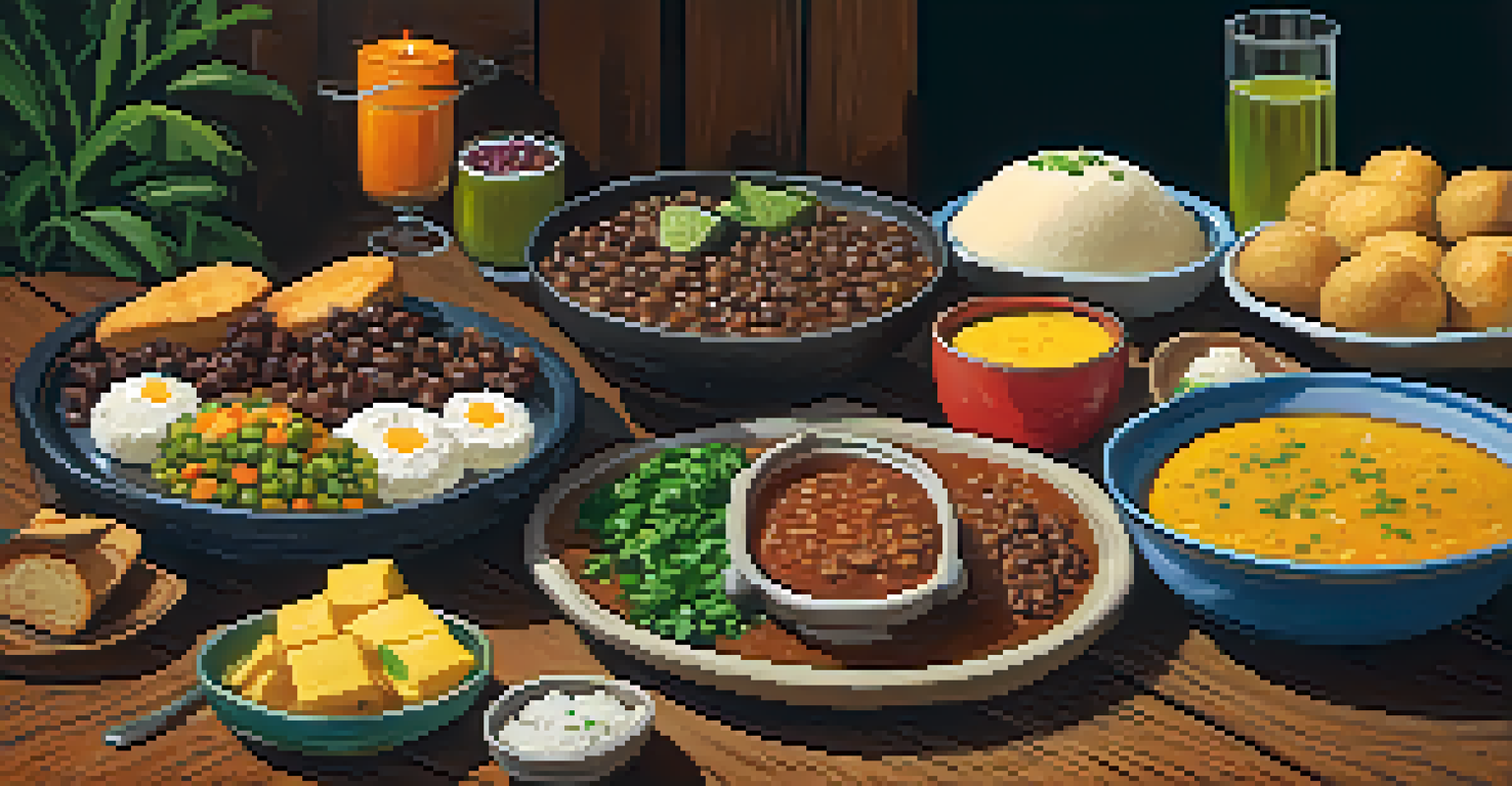Capturing the Culture: Brazil's Landscapes and Heritage

Brazil's Diverse Geography: A Tapestry of Landscapes
Brazil is a land of striking contrasts, from the lush Amazon rainforest to the sun-kissed beaches of Rio de Janeiro. This diversity creates a vibrant backdrop for the country’s culture, influencing everything from architecture to cuisine. Imagine standing in the heart of the Amazon, surrounded by towering trees and exotic wildlife, and then a few hours later, feeling the soft sand between your toes at Copacabana beach.
The beauty of Brazil is not just in its landscapes, but in the rich tapestry of cultures that thrive within it.
Each region of Brazil boasts its own unique landscape, which shapes the traditions and lifestyles of its inhabitants. For instance, the mountainous areas in the south are known for their wine production, while the northern regions are famous for their rubber trees and rich biodiversity. These geographical distinctions play a pivotal role in how communities connect with their surroundings and express their cultural identity.
Understanding Brazil's geography helps us appreciate the intricate relationship between the land and its people. It’s not just about breathtaking views; it's about how the environment influences art, music, and even the rhythms of daily life.
The Amazon: Heart of Biodiversity and Culture
The Amazon rainforest is often referred to as the lungs of the Earth, but it’s also a cradle of rich cultural heritage. Indigenous tribes have been guardians of this vast ecosystem for centuries, weaving their traditions and stories into the very fabric of the forest. By exploring this magnificent landscape, we uncover the deep connections between nature and the people who call it home.

Visitors to the Amazon can experience cultural practices that have been handed down through generations, from traditional crafts to unique culinary delights. Imagine tasting a dish made from local ingredients while listening to the rhythmic beats of a tribal drum. These experiences provide a glimpse into how the forest sustains not just the body, but the spirit.
Brazil's Geographic Diversity
Brazil's varied landscapes, from the Amazon to coastal cities, shape its culture and community traditions.
Moreover, the Amazon faces challenges from deforestation and climate change, making it crucial to support sustainable practices that honor both the environment and its indigenous cultures. Preserving this unique heritage is essential for future generations to appreciate the wonders of the Amazon.
Rio de Janeiro: Where Culture Meets Carnival
When you think of Brazil, Rio de Janeiro’s vibrant Carnival likely comes to mind. This annual festival is a dazzling display of music, dance, and elaborate costumes that reflect the city’s rich cultural diversity. It’s a time when locals and tourists alike come together to celebrate, transforming the streets into a colorful spectacle.
Food is a universal language that speaks to the heart of a culture, and in Brazil, it tells stories of heritage and community.
Beyond Carnival, Rio is home to iconic landmarks like the Christ the Redeemer statue and Sugarloaf Mountain, each with its own story to tell. These sites not only attract millions of visitors but also serve as symbols of Brazilian identity and resilience. The blend of natural beauty and urban energy creates an atmosphere that is both exhilarating and welcoming.
Exploring Rio means experiencing a culture that thrives on rhythm and community. Whether it’s in a samba school or a local food market, the spirit of Rio pulsates through every interaction, making it a must-visit destination for anyone looking to understand Brazil's heart.
Salvador: A Melting Pot of African Heritage
Salvador, the capital of Bahia, is renowned for its rich African heritage, which is evident in its music, dance, and cuisine. The city’s historic Pelourinho district is a UNESCO World Heritage site, showcasing colorful colonial architecture that tells the story of its past. Here, the influence of African culture is palpable, from the vibrant street art to the sounds of axé music filling the air.
One of the most celebrated aspects of Salvador is its traditional festivals, such as the Festa de Iemanjá, honoring the goddess of the sea. These events are a testament to the blending of African and Brazilian traditions, creating a unique cultural tapestry that is both lively and profound. Participating in these celebrations offers a firsthand experience of the city’s spirit and community.
Cultural Heritage in Festivals
Vibrant festivals across Brazil celebrate its rich cultural heritage, fostering community and shared history.
Salvador’s culinary scene is equally reflective of its heritage, with dishes like acarajé and moqueca delighting the taste buds. Each meal tells a story, inviting you to explore the flavors that have shaped the region for centuries. In Salvador, culture is not just observed; it's felt in every beat of the drum and every bite of food.
Pantanal: Nature’s Bounty and Cultural Significance
The Pantanal, the world’s largest tropical wetland, is a treasure trove of biodiversity and cultural significance. This vast ecosystem is home to an incredible array of wildlife, making it a paradise for nature lovers. However, it’s also a region where local communities have adapted their lifestyles to coexist with its unique environment.
In the Pantanal, traditional cattle ranching practices and artisanal fishing reflect a deep respect for the land. Local families often share their knowledge of sustainable practices that have been passed down through generations, emphasizing the importance of preserving both the landscape and their way of life. Learning from these communities enriches our understanding of Brazil’s rural heritage.
The Pantanal is not just a destination for wildlife enthusiasts; it’s a living example of how culture and environment intertwine. Engaging with local communities allows visitors to appreciate the delicate balance that sustains this remarkable ecosystem while celebrating the traditions that thrive within it.
Cultural Festivals: Celebrating Brazil's Heritage
Brazil is famous for its vibrant festivals that showcase the country's rich cultural heritage. Events like Festa Junina, celebrated in June, highlight traditional music, dance, and food from various regions. This festival, with its colorful decorations and lively dances, brings communities together, fostering a sense of belonging and pride in their roots.
Another prominent celebration is the Folklore Festival in São Luís, Maranhão, which pays homage to the diverse folklore of Brazil. This event features captivating performances that narrate tales passed down through generations, allowing participants to connect with their history. Festivals like these are vital in preserving cultural traditions and passing them on to future generations.
Culinary Diversity of Brazil
Brazilian cuisine reflects its diverse cultural influences, with regional dishes telling the story of the nation's heritage.
Participating in Brazil's festivals is not just about enjoyment; it's an opportunity to immerse oneself in the country's vibrant culture. These celebrations reflect the heart of Brazil, where joy, music, and community come together in a beautiful display of heritage.
Brazilian Cuisine: A Flavorful Journey Through Culture
Brazilian cuisine is a flavorful journey that mirrors the country's diverse cultural influences. From the savory feijoada, a black bean stew with pork, to the refreshing pão de queijo, a cheese bread, each dish tells a story of its origins. Food in Brazil is not just sustenance; it’s a celebration of the country's history and a reflection of its people.
Regional specialties further highlight Brazil's culinary diversity. In the northeast, the use of spices and seafood creates vibrant dishes, while the south is known for its barbecue and wine. Each region's cuisine offers a unique taste of its cultural heritage, inviting people to explore and appreciate the variety of flavors that Brazil has to offer.

Eating in Brazil is often a communal experience, where families and friends gather to share meals and stories. This sense of togetherness is a testament to the importance of food in Brazilian culture, making every meal an opportunity to connect with others and celebrate life.